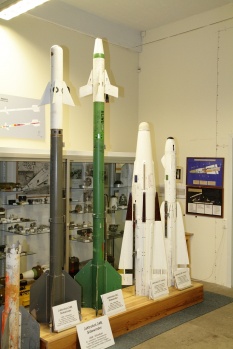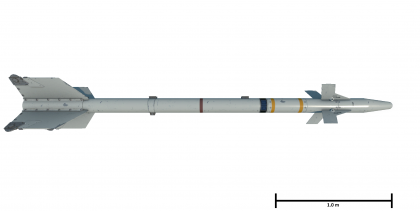AIM-9P Sidewinder
Contents
Description
The AIM-9P Sidewinder is a infra-red (IR) homing missile used on a variety of aircraft. An export version of the AIM-9 Sidewinder, the AIM-9P delivers performance akin to that of the AIM-9J that allow for the AIM-9P's use as a dog-fighting missile against low-manoeuvring aircraft.
Vehicles equipped with this weapon
General info
| Missile characteristics | |
|---|---|
| Mass | 76 kg |
| Guidance | IR |
| Aspect | Rear-Aspect |
| Lock range in rear-aspect | 5.5 km |
| Launch range | 18 km |
| Maximum speed | 2.5 M |
| Maximum overload | 20 G |
| Maximum overload during launch | 7 G |
| Missile guidance time | 40 secs |
| Explosive mass | 7.62 kg TNTeq |
Effective damage
Describe the type of damage produced by this type of missile (high explosive, splash damage, etc)
Comparison with analogues
Give a comparative description of missiles that have firepower equal to this weapon.
Usage in battles
Describe situations when you would utilise this missile in-game (vehicle, pillbox, base, etc)
Pros and cons
Summarise and briefly evaluate the weaponry in terms of its characteristics and combat effectiveness. Mark pros and cons as a list.
Pros:
Cons:
History
When the AIM-9L Sidewinder began to be put into production in 1976 replace other Sidewinder variants as the United States' main IR missile,[1] a need was created for Sidewinders to offer to the United States' allies that did not need or were not allowed access to the newest AIM-9 Sidewinder variants and their associated features such as all-aspect locking.[2]
The AIM-9P Sidewinder missile was developed as a family of export missiles. Sponsored by the US Air Force, this variant was based off the AIM-9J/N variants, though will be updated multiple times incorporating new features and improvements.[2][3]

- Variants of the AIM-9P
- AIM-9P - The first version, which is an improved AIM-9J model with greater engagement ranges. It also incorporates solid-state technology for better reliability and maintainability. Deliveries of this missile starts in 1978.[4]
- AIM-9P-1 - Introduces an active optical target detector with the DSU-15/B AOTD laser proximity fuze, replacing the old infrared influence fuze.[2][4]
- AIM-9P-2 - Introduces a reduced-smoke rocket motor.[2][4]
- AIM-9P-3 - Alongside the reduced-smoke rocket motor like the preceding P-2, the P-3 also includes a new insensitive munitions warhead and improved guidance and control section. Fuzing appears to be a mix of the original infrared fuze or the active optical target detector as the P-1.[2][4] The AIM-9P-3 is also the basis of the Swedish RB24J missile.[5]
- AIM-9P-4 - Introduces ALASCA features and technology of the AIM-9L variants.[2] However, it is considered less agile to the AIM-9L variant.[3]
- AIM-9P-5 - Introduces IRCCM incorporated in the AIM-9M variant.[2] This model is also the basis of the Swedish RB74, or RB24L, missile.[5]
More than 21,000 AIM-9P models were built during its production, though many were rebuilt AIM-9B/E/J. Despite being slated for export use, most of the missiles are in US Air Force inventory.[2]
Media
Excellent additions to the article would be video guides, screenshots from the game, and photos.
See also
Links to the articles on the War Thunder Wiki that you think will be useful for the reader, for example:
- reference to the article about the variant of the weapon;
- references to approximate analogues by other nations and research trees.
External links
- References
- Bibliography
- GlobalSecurity.org "AIM-9 Sidewinder." GlobalSecurity.org, Website. Accessed 02 Apr 2021 (Archive).
- Goebel, Greg. "The Falcon & Sidewinder Air-To-Air Missiles." Air Vectors, 01 Mar. 2021, Website. Accessed 02 Apr 2021 (Archive).
- Kopp, Carlo. "The Sidewinder Story: The Evolution of the AIM-9 Missile." Air Power Australia, 27 Jan 2014, Website. Accessed 02 Apr 2021 (Archive).
- Parsch, Andreas. "AIM-9." Directory of U.S. Military Rockets and Missiles, Designation-Systems.Net, 09 July 2008, Website. Accessed 02 Apr 2021 (Archive).
- Westrum, Ron. Sidewinder; Creative Missile Development at China Lake. Naval Institute Press, 30 Sep. 2013.




